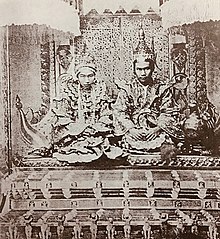Draft:Pataw M
 | Draft article not currently submitted for review.
This is a draft Articles for creation (AfC) submission. It is not currently pending review. While there are no deadlines, abandoned drafts may be deleted after six months. To edit the draft click on the "Edit" tab at the top of the window. To be accepted, a draft should:
It is strongly discouraged to write about yourself, your business or employer. If you do so, you must declare it. Where to get help
How to improve a draft
You can also browse Wikipedia:Featured articles and Wikipedia:Good articles to find examples of Wikipedia's best writing on topics similar to your proposed article. Improving your odds of a speedy review To improve your odds of a faster review, tag your draft with relevant WikiProject tags using the button below. This will let reviewers know a new draft has been submitted in their area of interest. For instance, if you wrote about a female astronomer, you would want to add the Biography, Astronomy, and Women scientists tags. Editor resources
Last edited by Boleyn (talk | contribs) 14 days ago. (Update) |
 | |
| Date | November 29, 1885 |
|---|---|
| Location | |
| Cause | Forced abdication of Thibaw Min, the victory of British Empire and the failure of Kingdom of Konbaung in the Third Anglo-Burmese War |
| Participants |
|
On 29 November 1885, Thibaw Min, the last king of Burma, his senior queen, Supayalat and Burmese royals were exiled to Ratnagiri, India, a port city off the Arabian Sea after defeated by British Empire in the Third Anglo-Burmese War. The banishment was called Pataw Mu (Burmese: ပါတော်မူ; MLCTS: pattaumhu:, pronounced [pàtàʊ m̥ù]) which means taken away.
Background[edit]
Biographies of Thibaw Min and Supayalat (Summary)[edit]
Thibaw Min, born Maung Yay Set in 1859, was the last king of Burma from the Konbaung dynasty. He was the son of Mindon Min and Laungshe Mibaya, one of his consorts. Thibaw's mother had been banished from the palace court by Mindon and spent her final years as a thilashin (သီလရှင်). Thibaw succeeded his father in 1878 after a massacre that ended with the deaths of many royals. He was exiled to Ratnagiri, India (then British India) after the British invasion of Mandalay in 1885. Thibaw's wife, Supayalat, was known for her ambition and advocacy for war with the British. She was the half sister of Thibaw and they fell in love while Thibaw's monkhood. She was said to have forced monogamy on Thibaw, breaking ancient custom. After Thibaw's death in 1916, Supayalat fought in vain for the right to take her husband's body back to Burma for burial.

The Third Anglo-Burmese War[edit]
Main article - Third Anglo-Burmese War
The Third Anglo-Burmese War, the final conflict in a series of wars between the British Empire and the Kingdom of Konbaung occurred from 7 to 29 November 1885 with sporadic resistance continuing into 1887. This war marked the end of Burma's independence under the Konbaung dynasty as the British had already annexed Lower Burma in 1853 after the Second Anglo-Burmese War. The Third War was triggered by British concerns over French influence in Burma and a boundary dispute between India and Burma.
The British, fearing French expansion in Southeast Asia, sought to assert their dominance in the region. Tensions escalated when the British unilaterally marked the border between India and Burma, leading to Burmese objections. In response, the British launched a military campaign to secure their interests and extend their control over Burma.
British forces swiftly advanced towards Mandalay, the Burmese royal capital, facing minimal resistance. King Thibaw Min and his queen, Supayalat were captured and exiled to Ratnagiri in British India. This marked the end of Burmese sovereignty, as the country came under [[British rule|British rule in Burma as a province of the British Raj.
The aftermath of the war saw Burma governed as a separate colony by the British until it gained independence as a republic in 1948. The Third Anglo-Burmese War had lasting implications for Burma, shaping its future political landscape and relationship with the British Empire. It marked the end of an era for the Burmese monarchy and the beginning of a new chapter in the country's history under British colonial rule.


See also[edit]
References[edit]
